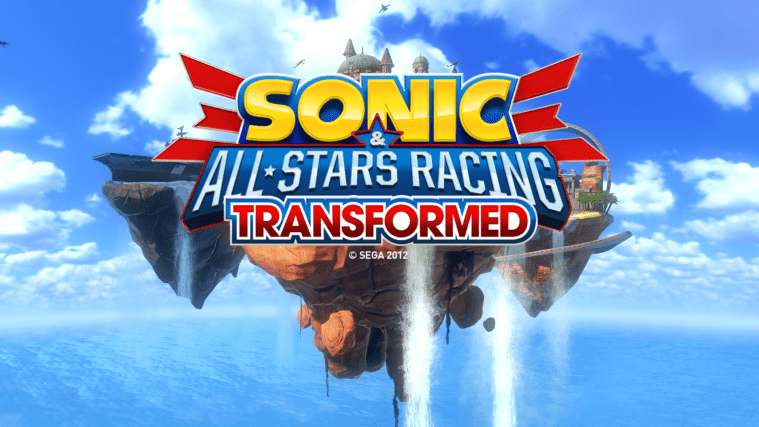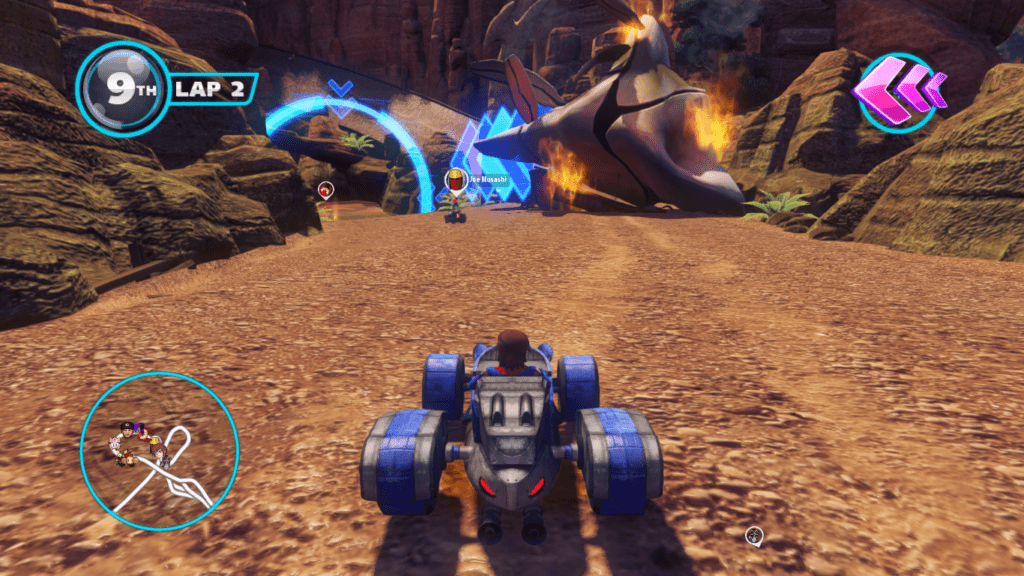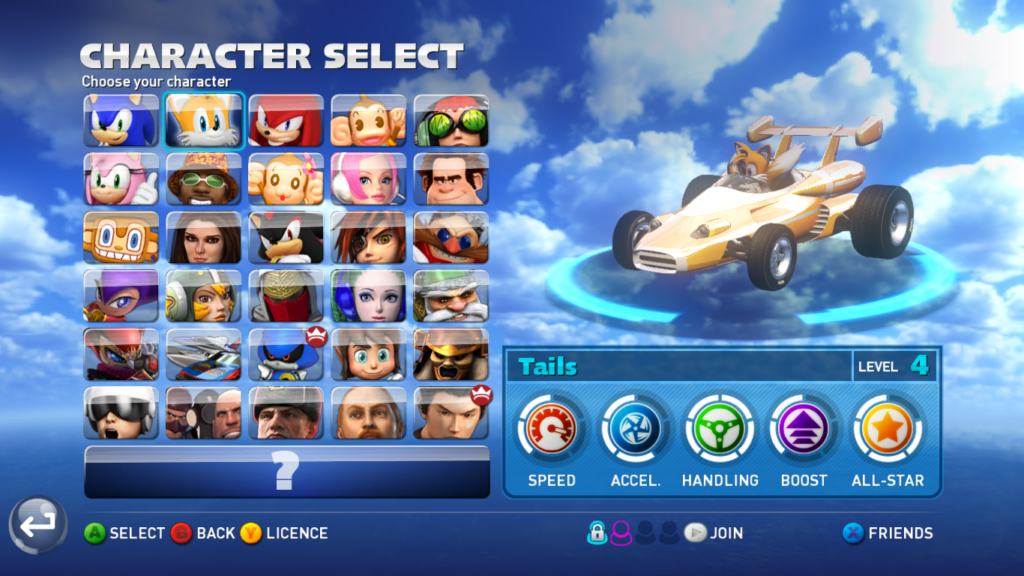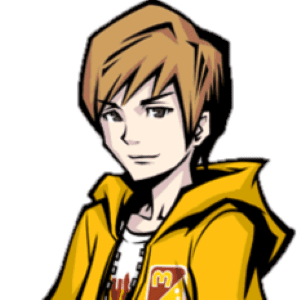Many genres of video games are practically synonymous with a fun night hanging out with friends. If you ask me, none are more synonyms than kart racers. The approachability of racing as a concept that anyone can immediately understand combined with the chaos of random items and the occasional skillful outplays against it that wow everyone in the room coalesces into a genre of games that rightly find its way onto most gamers’ shelves. But rather than simply look at the juggernaut of kart racers that is Mario Kart, or even the most recent game in today’s “series” (Team Sonic Racing), I want to explore what I consider to be the most interesting kart racer I’ve ever played, and see if it’s still worth your attention nine years later.

Developed by Sumo Digital and published by Sega, Sonic and All-Stars Racing Transformed is a multi-vehicular speed competition game released in November of 2012 on the Playstation 3, Xbox 360, and Wii U, and later for Playstation Vita, PC, and Nintendo 3DS. The premise involves a crossover between video game icon Sonic the Hedgehog and other classic game characters (along with a few wildcards) racing in cars that can transform into boats and planes while speeding through various locations based on Sega’s history.
Please note that this will be a review of the Steam version of the game, and your experience, especially on handheld consoles, may differ both in quality and in some of the playable characters featured in the game.
Perhaps the best place to start is with the game’s status as a crossover between several IPs. The game’s roster prominently features characters from the Sonic the Hedgehog series, but also includes a substantial number of characters from other franchises owned by Sega. What’s interesting about this is that Sega has actually rarely bothered to release new titles in the series represented here other than Sonic and Super Monkey Ball since they stopped making consoles at the end of the 20th century. On one hand it’s understandable that the lack of many recognizable characters may be a turn-off for some, but I would encourage you to go into the game and try to see it as a showcase of gaming history. At the very least there are also some characters which represent non-Sega properties, mostly from more modern PC games, so there may be more recognition among those. With all these different corners of gaming coming together though, I would like to mention that their presence may entice interest in the properties the characters represent, and parents should know that not all of them are family friendly, even if their portrayal in the game is mostly harmless. For instance the Team Fortress 2 character is definitely goofy enough and fits this game’s cartoonish aesthetic, but the actual shooter by the same name is rightly M-rated. On one final tangent regarding the roster, the game also includes two characters that represent a time capsule of the game’s release window, featuring Wreck-It Ralph, the titular protagonist from a video game themed film by Disney, and then Nascar driver Danica Patrick. These two product placements definitely have not aged well, but I find their presence all the more hilarious for it.

Given that racing games are pretty self-explanatory, I’ll focus the mechanical analysis of the game on what it does uniquely. The game’s primary marketing hook is the fact that your vehicles transform at specific points in the race between car, boat, and plane forms. Cars control pretty typically for a racer, boats are affected by ripples of the water, and planes emphasize both vertical and lateral movement. This helps make controlling your vehicle more varied and to that end it’s a good system. What the game doesn’t tell you up front, and in my opinion is the smartest design choice of this game, is that most courses change dynamically between laps. On lap one you could be on a standard car course, and the next debris from a crash will block the previous path and the race continues by plunging into a nearby river. “Transformed” refers not only to your mode of transit but also the raceway itself, and having there be only a handful of courses in the game where you can truly check out and coast along a memorized best route does so much for the game’s fun factor. As far as driving skills are involved, there’s a pretty intricate boost system which rewards performing tricks off of ramps, drifting for long periods of time, and rolling out of the way of obstacles while flying with a burst of speed. These techniques require a certain level of learning how to get your vehicle to do what you want (not unlike actual driving), but it is also the most satisfying system of the game to master as being able to chain these techniques together is, both literally and metaphorically, quite a rush.
Another important point about this game is the power-up system, which is surprisingly skill based and offers a lot of flexibility and counterplay. Pufferfish which can be used either as a bouncy forward projectile or placed behind you as a stationary trap which can persist between laps. RC car-bombs automatically chase down their target but can be avoided by activating a boost at just the right moment before it hits you. Snowballs that can be fired one at a time to spread around smaller speed penalties or all at once to slow a single target significantly. Swarms of yellow jackets that set themselves up at the lead driver’s position and force players to maneuver around them or be slowed down. Almost every item in the game has either a secondary use or a skill-based method of mitigating them, and this results in a system which both provides the wild thrills of random chance while also respecting a higher level of play. It’s not hyperbole to say that Sonic and All-Stars Racing Transformed may have the best item system ever put in a racing game. The one blight which keeps it from being perfect though is the All-Star move, an uncommon item allowing players to turn invincible, move super fast, and attack other racers. This results in two wildly different balance issues. On one hand, its immense speed interacts oddly with certain boundaries like the ones around low ramps and causes you to fall off the stage in places where you swear you were on track. On the other hand, you can get this in 2nd place occasionally, letting you rocket way ahead and more or less win on the spot!
If I had one major complaint about the game’s mechanics, it’s that the physics aren’t quite as fine-tuned as they probably should be. The main example I can think of is hitting a rail or what have you slows down your momentum by a very significant degree. This is generally not an issue and if anything it raises the game’s skill ceiling, but occasionally you’ll hit something in mid-air while jumping off a ramp and wind up slowly descending down back to the ground. While you can technically use this coyote time to easily pull off a level 3 trick boost this doesn’t often grant enough speed to make up for the time you lost, or just for how awkward and wrong it feels. For all the care put into this game, there’s also stuff like this which betrays its status as a budget title.
Outside of the main racing and grand prix modes, there’s also a lengthy mission mode called World Tour. This mode is the method by which all but one of the characters are unlocked, and features a variety of different events which teach you different skills. Weaving through mock rush hour traffic to practice avoiding hitting other drivers, flying through rings to get a handle on plane controls, and races where each driver can take three hits before being eliminated to practice lining up weapon shots are just a few of the modes that pop up here. This mode’s progression system even encourages improvement, as there are gates and unlockables which require certain quantities of merit stars, and if you haven’t been playing on higher difficulties these checkpoints will inevitably make you go back and tackle tougher versions of the missions you already did. It’s overall a really fun and well thought out mode that’s not a chore to clear, although it is a single-player mode through and through. Speaking of progression, the game’s long term progression system is Mod unlocks, which rewards sticking to the same driver over multiple races with the ability to do some stat tuning on the character select screen. It’s a nice system which allows you to play your favorite characters in ways that match your preferred strategy and encourages you to spend time with all of the game’s playable drivers, though I definitely wouldn’t worry too much about unlocking every mod for every character because that would take a very long time.

As for the game’s presentation, there’s a little bit of both good and bad to it. To start with the bad, for a game about bringing various characters together the drivers have very stiff animations. While these only really matter on specific screens, it’s very noticeable when it does happen. Many of the characters are also given their voices through archival clips to save on the acting budget, and if you’re familiar with the clips it can definitely be jarring. Another point of contention is the game’s music, which is mostly a mixture of old tracks ripped from their games of origin and remixes. It’s a good soundtrack overall, but many of the remixes and original themes lean heavily into synthesized music, which in my book often only works in scenarios of extremely high action or tension… which doesn’t apply to scrolling around a menu. On to the good stuff, one is apt to immediately notice the excellent environment design for each of the race courses. These are often quite detailed and pay great homage to the aesthetics of the games they are inspired by. I can’t think of a single track which isn’t fun to just drive through. The other major success is the game’s ability to convey a sense of speed. The camera that pulls back, the sound and sight of the booster going off, the subtle screen shake and speed lines… the developers knew a game with Sonic on the cover needed to feel fast and to that end I applaud them.
So in conclusion, Sonic and All-Stars Racing Transformed is a delightfully well designed racing game whose mechanics and game modes are masterfully tailored towards players of all skill levels and interests. While it doesn’t break free of some of its more cost-saving measures, there’s enough good here that players willing to endure a little jank will find an excellent game that’s still fun to play to this very day. Just be warned, the veteran players in the public online lobbies are inhumanly good at getting great lap times!
St. Christopher, St Brendan the Navigator, St. Joseph of Cupertino, pray for us.
Scoring: 80%
Gameplay: 4/5
Art and Graphics: 4/5
Music: 3/5
Replayability: 5/5
Morality/Parental Warnings
Certain characters featured in the game come from various other intellectual properties, and while their inclusions are executed harmlessly they may generate interest in games with varying levels of moral integrity. The two characters from Space Channel 5 (Ulala and Pudding) wear outfits which reveal a fair bit of skin. A few characters and stages have aesthetics which allude to magic, mostly the inclusions from the NiGHTS series. A horror themed stage features some zombies shambling about and a demon-esque monster tearing up the roof of a mansion. At least one of the characters will use a little bit of unclean language in one of their voice clips, although I’m not sure which one. Online interactions come with the standard cautions.
